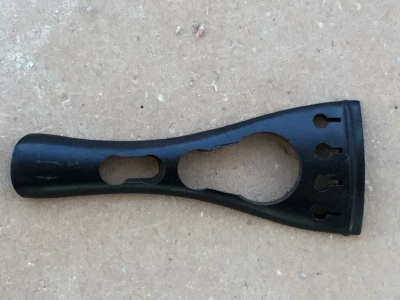Welcome to our forum. A Message To Our New and Prospective Members . Check out our Forum Rules. Lets keep this forum an enjoyable place to visit.
Currently working on errors from the latest (SimplePress) forum update. Many issues have been resoled and others are being worked on. Thank you for your patience.
 Topic RSS
Topic RSS



 (0 votes)
(0 votes) Regulars
 Offline
Offline

I recently came upon an eBay auction for a skeletonized harp style cello tailpiece manufactured by Frirsz. It certainly looked interesting and I think that it would be fairly simple to do with a router once a jig was prepared. The wood direction in the "cross member" would be rather weak but likely adequate because it is acting in compression. This area could also be reinforced with a carbon fiber rod. I see no reason why this could not be done on violin and viola tailpieces (conventional and harp) and removing material (and therefore mass) from the tailpiece would appear to be an easy method for obtaining greater harmonics and sustain.
Success is the progressive realisation of a worthy ideal. —Earl Nightingale.
Regulars
 Offline
Offline

Logically, the tail piece would have less mass if a 3/4 one was used on a full sized (4/4) violin. Rosewood has less density than ebony, and boxwood has the least of the three. I think that I am going to purchase a couple of rosewood 3/4 sized tail pieces and put them on the "healing bench" to skeletonize them like the Frirsz. I will put them on a violins (assuming I done kill one of the tail pieces in the process) with Knilling planetary pegs (easy for me, since all of mine have them) since it makes no sense to reduce the mass of the tailpiece (and increase string after length) and then cobble fine tunes on it.
Success is the progressive realisation of a worthy ideal. —Earl Nightingale.
Regulars
 Offline
Offline

Regulars
 Offline
Offline

MrYikes (and others). I plan to take a lot more wood than your experiment. I need to obtain a tailpiece without string holes since I plan to remove wood up to about where the holes are drilled (leaving the area where a conventional tail piece is slotted for the strings) and will drill holes through the end of the tailpiece and pass the strings through those holes. The string balls will be visible through "skeleton." I am making the assumption that the tail piece "bridge" is an un-needed appendage in my configuration and I will not get a buzz. I think that the silk binding on the strings will prevent it. Time will tell. This is similar to that used in the "Electric Viol" shown on Youtube videos and your excitement on my posting of the upside down strings tailpiece.
If you look at the website for the Frirsz cello tailpiece, you will get some idea of what I am doing (but I am going to be removing more wood toward the string end).
Obviously, in no way can I use a fine tuner with this modification so, in order for it to work, I need to use Knilling planetary pegs. I have already purchased two sets at $40 per set on eBay.
My original set will be in ebony since that is what is available to me. If I can establish a relationship with the seller, I will try to get a couple in maple since my experiment in roasting maple (other thread) is proceeding well. Maple is much lighter than ebony and boxwood so, in theory, should vibrate better.
Success is the progressive realisation of a worthy ideal. —Earl Nightingale.
Regulars
 Offline
Offline

Hi MrYikes (and others). Your photo pushed me to action. I just got done boring some holes in an ebony tailpiece as a "proof of concept." The curves had not been smoothed yet. I quickly learned that ebony does not like to be chiseled.
The quick story of my life when it comes to projects is that the second one generally works. The third one looks pretty. And the forth one and beyond (where the money is made) are never made since I have become bored and have moved onto another project.
If the "proof of concept" is promising on an actual violin, I plan to purchase some boxwood tail pieces of 3/4 size to completely minimize mass. See photo below:
 _
_
Success is the progressive realisation of a worthy ideal. —Earl Nightingale.


 Log In
Log In Register
Register






















